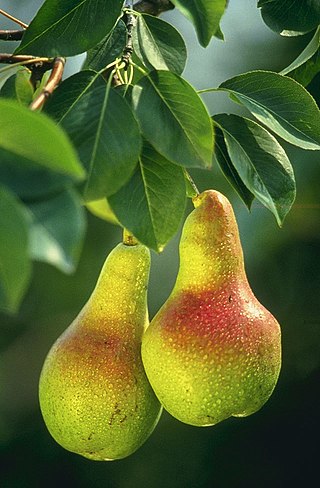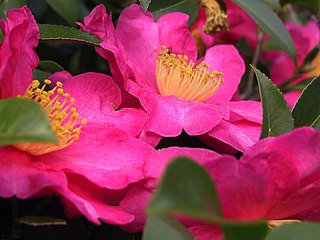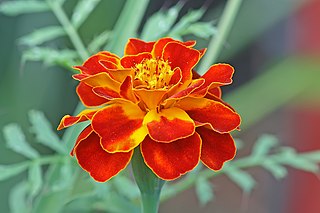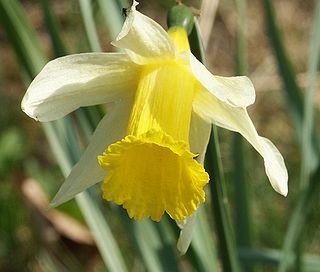
Pears are fruits produced and consumed around the world, growing on a tree and harvested in late summer into mid-autumn. The pear tree and shrub are a species of genus Pyrus, in the family Rosaceae, bearing the pomaceous fruit of the same name. Several species of pears are valued for their edible fruit and juices, while others are cultivated as trees.

Begonia is a genus of perennial flowering plants in the family Begoniaceae. The genus contains more than 2,000 different plant species. The Begonias are native to moist subtropical and tropical climates. Some species are commonly grown indoors as ornamental houseplants in cooler climates. In cooler climates some species are cultivated outside in summertime for their bright colorful flowers, which have sepals but no petals.

The Royal Horticultural Society (RHS), founded in 1804 as the Horticultural Society of London, is the UK's leading gardening charity.

Dahlia is a genus of bushy, tuberous, herbaceous perennial plants native to Mexico and Central America. As a member of the Asteraceae family of dicotyledonous plants, its relatives include the sunflower, daisy, chrysanthemum, and zinnia. There are 49 species of dahlia, with flowers in almost every hue, with hybrids commonly grown as garden plants.

Camellia is a genus of flowering plants in the family Theaceae. They are found in tropical and subtropical areas in eastern and southern Asia, from the Himalayas east to Japan and Indonesia. There are more than 220 described species. Camellias are popular ornamental, tea and woody-oil plants that have been cultivated throughout the world for centuries. To date, over 26,000 cultivars, with more than 51,000 cultivar names including synonyms, have been registered or published.

Clematis is a genus of about 380 species within the buttercup family, Ranunculaceae. Their garden hybrids and cultivars have been popular among gardeners, beginning with Clematis 'Jackmanii', a garden staple since 1862; more cultivars are being produced constantly. They are mainly of Chinese and Japanese origin.

Aeonium, the tree houseleeks, is a genus of about 35 species of succulent, subtropical plants of the family Crassulaceae. Many species are popular in horticulture. The genus name comes from the ancient Greek αἰώνιος / aiōnios (ageless). While most of them are native to the Canary Islands, some are found in Madeira, Cape Verde, Morocco, in East Africa and Yemen.

Hosta is a genus of plants commonly known as hostas, plantain lilies and occasionally by the Japanese name gibōshi. Hostas are widely cultivated as shade-tolerant foliage plants. The genus is currently placed in the family Asparagaceae, subfamily Agavoideae, and is native to northeast Asia. Like many "lilioid monocots", the genus was once classified in the Liliaceae. The genus was named by Austrian botanist Leopold Trattinnick in 1812, in honor of the Austrian botanist Nicholas Thomas Host. In 1817, the generic name Funkia was used by German botanist Kurt Sprengel in honor of Heinrich Christian Funck, a collector of ferns and alpines; this was later used as a common name and can be found in some older literature.

Tagetes patula, the French marigold, is a species of flowering plant in the family Asteraceae, native to Mexico and Guatemala with several naturalised populations in many other countries. It is widely cultivated as an easily grown bedding plant, with thousands of different cultivars in brilliant shades of yellow and orange.

Erica carnea, the winter heath, winter-flowering heather, spring heath or alpine heath, is a species of flowering plant in the family Ericaceae, native to mountainous areas of central, eastern and southern Europe, where it grows in coniferous woodlands or stony slopes.

The Plant Review, published quarterly by the Royal Horticultural Society, is a 68-page magazine containing "fascinating in-depth articles for everyone who loves plants". Its authoritative articles are written by acknowledged experts on plant-related subjects, and include plant profiles, horticulture, botany and the development of garden plants, focusing on ornamental plants grown in temperate gardens. It also reflects the scientific work of the RHS, as well as research conducted by other horticultural and botanical institutions and individuals. First published in 1979 as The Plantsman, it was renamed The Plant Review from September 2019.

Narcissus pseudonarcissus, commonly named the wild daffodil or Lent lily, is a perennial flowering plant.

William Thomas Stearn was a British botanist. Born in Cambridge in 1911, he was largely self-educated and developed an early interest in books and natural history. His initial work experience was at a Cambridge bookshop, but he also had a position as an assistant in the university botany department. At the age of 29 he married Eldwyth Ruth Alford, who later became his collaborator, and he died in London in 2001.

Gazania is a genus of flowering plants in the family Asteraceae, native to Southern Africa.
The field elm cultivar Ulmus minor 'Silvery Gem' is an ornamental clone raised, as Ulmus carpinifolia 'Silvery Gem', before 1965 by P. G. Zwijnenburg of Zwijnenburg nurseries, Boskoop, The Netherlands.

Jasminum officinale, known as the common jasmine or simply jasmine, is a species of flowering plant in the olive family Oleaceae. It is native to the Caucasus and parts of Asia, also widely naturalized.
Raymond John Evison is a nurseryman, clematis breeder, lecturer, author and photographer. Born in 1944 he started his horticultural career at the age of 15 in Shropshire and moved to the island of Guernsey to set up The Guernsey Clematis Nursery in 1984.

The American Conifer Society was founded in 1983 to help educate the public about conifers, which are cone-bearing plants. The Society is governed by a board of directors with representation from each of the Society's four regions. The Society publishes the ConiferQuarterly in both digital and hard copy versions and maintains a public website which hosts an extensive conifer database as well as copious articles about identifying, growing and designing with conifers. In addition, the Society holds annual events, including small, informal gatherings and a national meeting, which is rotated among the four regions.

David Charles McClintock, MBE, VMH, FLS (1913–2001) was an English natural historian, botanist, horticulturist and author. McClintock was notably active in the worlds of natural history, horticulture and botany within the UK and Europe. He was the co-author of a popular flora, which sold a quarter of a million copies, and of many other books, papers and reviews. He recorded more than 3,000 species in the British Isles gathered from throughout the UK and seen a vast range of rarities – aliens being a particular focus. An amateur, McClintock also worked across the worlds of botany and horticulture, and organised a scientific survey of the natural history of Buckingham Palace Garden. He has been described as "one of the most distinguished and productive amateur botanists of his generation".

















